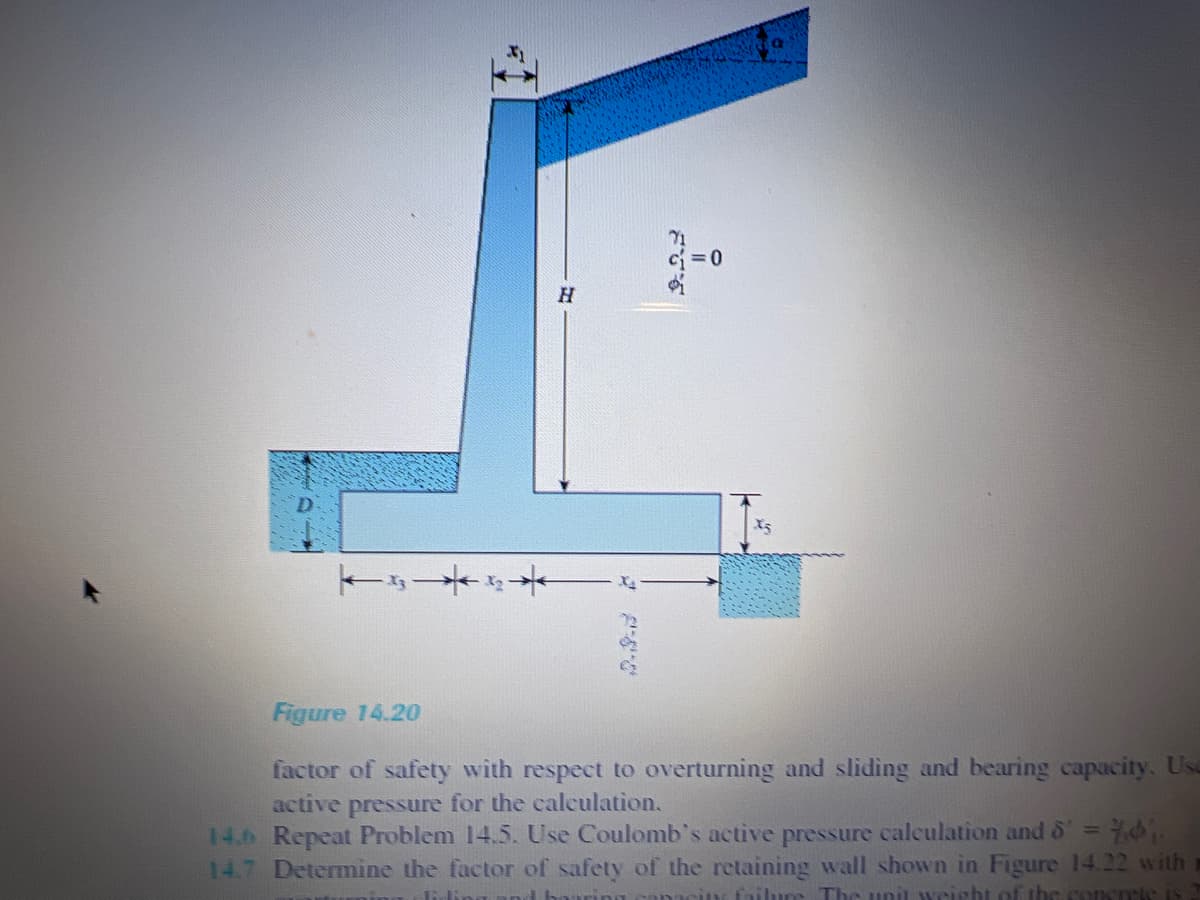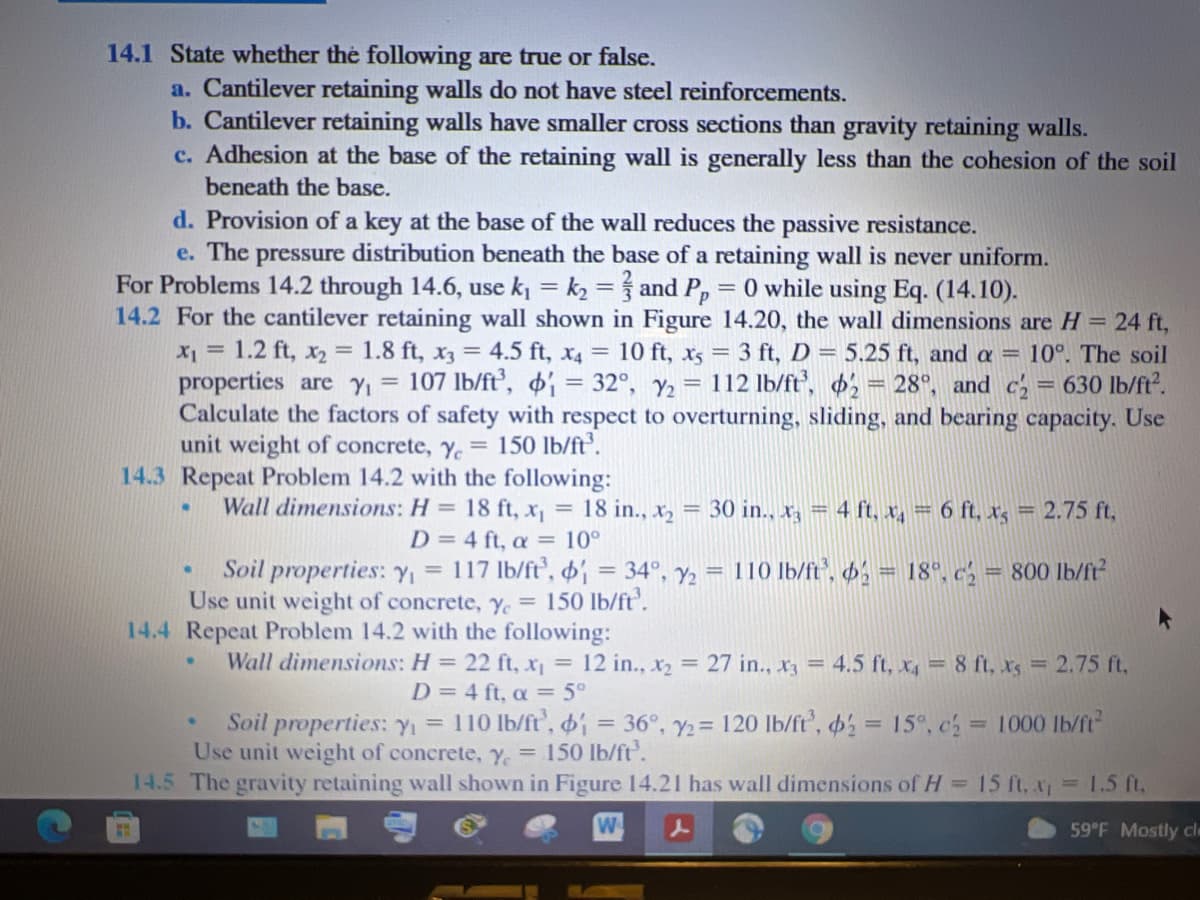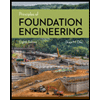14.2 For the cantilever retaining wall shown in Figure 14.20, the wall dimensions are H = 24 ft, X1 = 1.2 ft, x2 = 1.8 ft, x3 = 4.5 ft, x4 = 10 ft, xs = 3 ft, D = 5.25 ft, and a = 10°. The soil properties are Y = 107 lb/ft', 'i = 32°, y2 = 112 lb/ft’, = 28°, and c = 630 Ib/ft. Calculate the factors of safety with respect to overturning, sliding, and bearing capacity. Use unit weight of concrete, y. = 150 lb/ft'.
14.2 For the cantilever retaining wall shown in Figure 14.20, the wall dimensions are H = 24 ft, X1 = 1.2 ft, x2 = 1.8 ft, x3 = 4.5 ft, x4 = 10 ft, xs = 3 ft, D = 5.25 ft, and a = 10°. The soil properties are Y = 107 lb/ft', 'i = 32°, y2 = 112 lb/ft’, = 28°, and c = 630 Ib/ft. Calculate the factors of safety with respect to overturning, sliding, and bearing capacity. Use unit weight of concrete, y. = 150 lb/ft'.
Fundamentals of Geotechnical Engineering (MindTap Course List)
5th Edition
ISBN:9781305635180
Author:Braja M. Das, Nagaratnam Sivakugan
Publisher:Braja M. Das, Nagaratnam Sivakugan
Chapter15: Retaining Walls, Braced Cuts, And Sheet Pile Walls
Section: Chapter Questions
Problem 15.3P
Related questions
Question
I need answer only for question NO 14.2

Transcribed Image Text:H
Figure 14.20
factor of safety with respect to overturning and sliding and bearing capacity. Usa
active pressure for the calculation.
14.6 Repeat Problem 14.5. Use Coulomb's active pressure calculation and & = .
14.7 Determine the factor of safety of the retaining wall shown in Figure 14.22 with
failure The uniL weight of the concrete is

Transcribed Image Text:14.1 State whether the following are true or false.
a. Cantilever retaining walls do not have steel reinforcements.
b. Cantilever retaining walls have smaller cross sections than gravity retaining walls.
c. Adhesion at the base of the retaining wall is generally less than the cohesion of the soil
beneath the base.
d. Provision of a key at the base of the wall reduces the passive resistance.
e. The pressure distribution beneath the base of a retaining wall is never uniform.
For Problems 14.2 through 14.6, use k = k2 = and P, = 0 while using Eq. (14.10).
14.2 For the cantilever retaining wall shown in Figure 14.20, the wall dimensions are H = 24 ft,
1.2 ft, x2 = 1.8 ft, x3 = 4.5 ft, x4 = 10 ft, x5 = 3 ft, D = 5.25 ft, and =
10°. The soil
= Ix
properties are YI = 107 lb/ft', i = 32°, y2 = 112 lb/ft, = 28°, and c = 630 lb/ft.
Calculate the factors of safety with respect to overturning, sliding, and bearing capacity. Use
unit weight of concrete, y, = 150 lb/ft'.
14.3 Repeat Problem 14.2 with the following:
Wall dimensions: H = 18 ft, x, = 18 in., x2
30 in., x, = 4 ft, x = 6 ft, xg = 2.75 ft,
%3D
D = 4 ft, a = 10°
110 Ib/ft", ; = 18", c = 800 lb/ft²
Soil properties: YI = 117 lb/ft', i = 34°, y2 =
Use unit weight of concrete, y = 150 lb/ft'.
14.4 Repeat Problem 14.2 with the following:
Wall dimensions: H = 22 ft, x = 12 in., x2 = 27 in., x3 = 4.5 ft, x = 8 ft, xs = 2.75 ft,
%3D
D = 4 ft, a = 5°
Soil properties: yI = 110 lb/ft', 6i = 36°, y2= 120 lb/ft', = 15°, ch = 1000 lb/ft
150 lb/ft.
14.5 The gravity retaining wall shown in Figure 14.21 has wall dimensions of H = 15 ft, x = 1.5 ft,
Use unit weight of concrete, Ye =
W
59 F Mostly cle
Expert Solution
This question has been solved!
Explore an expertly crafted, step-by-step solution for a thorough understanding of key concepts.
This is a popular solution!
Trending now
This is a popular solution!
Step by step
Solved in 3 steps with 1 images

Knowledge Booster
Learn more about
Need a deep-dive on the concept behind this application? Look no further. Learn more about this topic, civil-engineering and related others by exploring similar questions and additional content below.Recommended textbooks for you

Fundamentals of Geotechnical Engineering (MindTap…
Civil Engineering
ISBN:
9781305635180
Author:
Braja M. Das, Nagaratnam Sivakugan
Publisher:
Cengage Learning

Principles of Foundation Engineering (MindTap Cou…
Civil Engineering
ISBN:
9781337705028
Author:
Braja M. Das, Nagaratnam Sivakugan
Publisher:
Cengage Learning

Principles of Geotechnical Engineering (MindTap C…
Civil Engineering
ISBN:
9781305970939
Author:
Braja M. Das, Khaled Sobhan
Publisher:
Cengage Learning

Fundamentals of Geotechnical Engineering (MindTap…
Civil Engineering
ISBN:
9781305635180
Author:
Braja M. Das, Nagaratnam Sivakugan
Publisher:
Cengage Learning

Principles of Foundation Engineering (MindTap Cou…
Civil Engineering
ISBN:
9781337705028
Author:
Braja M. Das, Nagaratnam Sivakugan
Publisher:
Cengage Learning

Principles of Geotechnical Engineering (MindTap C…
Civil Engineering
ISBN:
9781305970939
Author:
Braja M. Das, Khaled Sobhan
Publisher:
Cengage Learning

Principles of Foundation Engineering (MindTap Cou…
Civil Engineering
ISBN:
9781305081550
Author:
Braja M. Das
Publisher:
Cengage Learning